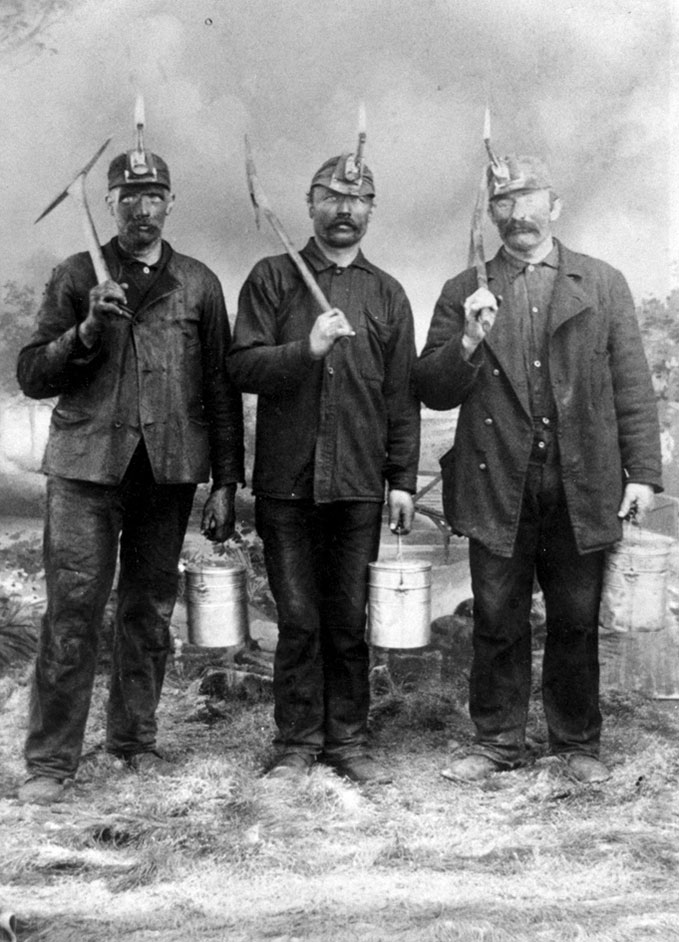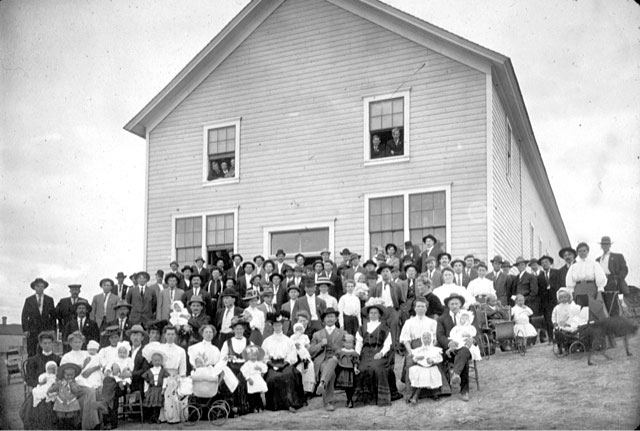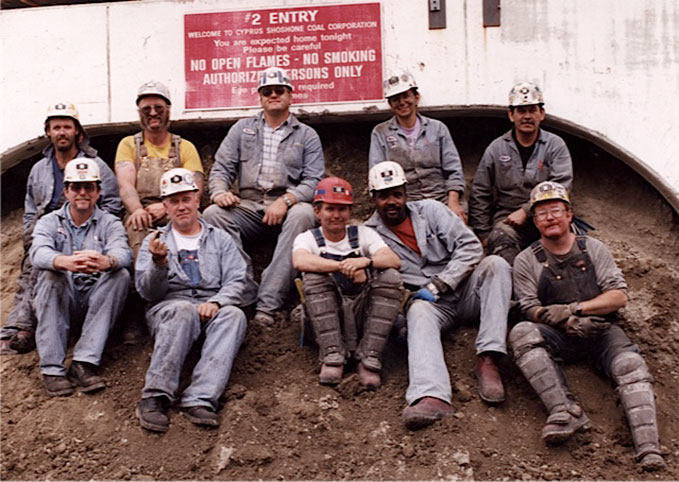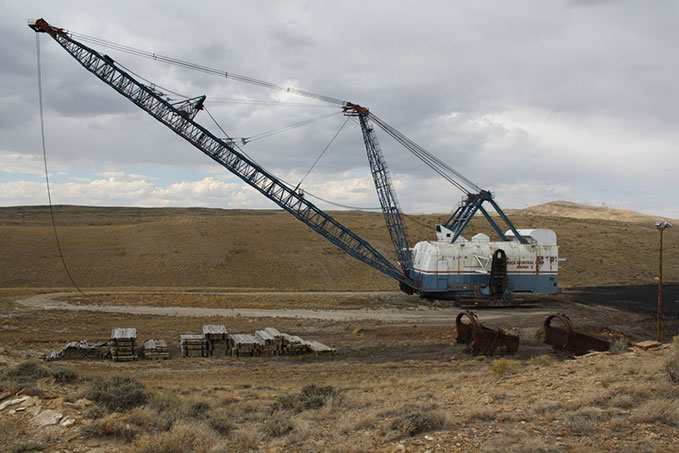- Home
- Encyclopedia
- A Brief History of Hanna, Wyoming
A Brief History of Hanna, Wyoming
“Coal is King,” proclaims a yearly celebration in Hanna, Wyo. The sentiment is echoed by the dragline on the horizon to the north. The Arch Mineral Corporation’s Page model 742 was notable in its day and worked from 1977 to 2005 uncovering coal and reclaiming pits. Of the dozen or so goliath machines once working the strip mines of the Hanna Basin, it is the sole, now silent, survivor.

During the winter of 1889, workmen began opening Union Pacific mines at Chimney Springs, soon renamed Hanna in honor of Mark A. Hanna. A year earlier, the Cleveland, Ohio-based coal and shipping magnate had convinced Union Pacific powers that the railroad’s future lay in the retention and development of its coal fields.
Prospects in the area were good; seams were between 15 and 30 feet thick. The company officials hastily brought the No. 1 Mine in production. From its inception in 1890 until the closing of its Hanna mines in 1954, the Union Pacific Coal Company opened six mines, some mere prospect holes, others long-lived collieries.
A company town from the start
Hanna was an exemplary, if primitive, company town, with rows of identical houses punctuated by privies and coalhouses in the alleys, and nearby company structures dedicated to commerce and social interaction.
Miners and their families were defined by workplace. One Town by No. 1 Mine was a compact area occupying a treeless flood plain. As mines were added, so were accompanying villages Two Town and Three Town. While ethnic and racial groups might concentrate within areas, the towns were essentially integrated. Exceptions were Jap Town, a settlement near No. 2 Mine, where space allowed expansive gardens. Elmo, a Finnish village incorporated in 1917 was located a mile to the east of Hanna, beyond the controlling reach of the company. In Elmo, saloons and other types of free enterprise flourished.
“Mine No. One is a pathetic story of grief for the company, its employees and their families.” In that order History of Union Pacific Coal Mines described the impact of the tragedies of June 30, 1903, and March 28, 1908. With 228 fathers, brothers, sons, uncles and friends lost, Hanna became a town of widows. Decades later, Wyoming magazine’s Editor Mike Leon pondered what was unique about Hanna: “Its atmosphere is different … They have united over barriers that divide men elsewhere, have drawn together in a shared, prideful tradition … and in a common sorrow.”
The United Mine Workers of America
The “shared, prideful tradition” was sustained in part by entities outside the company’s domain; this included the miners’ union. The late Muriel Kitching, Hanna historian, related in her memoir that a United Mine Workers organizer disembarked from a Union Pacific train outside town limits in 1906 and hiked the quarter mile to the top of Spion Kop Hill (named by British miners after an important hill and battle in the Boer War) where he enrolled willing miners.

In 1907, faced with a general strike, a dearth of replacement laborers and a rising market, the coal company formally recognized the United Mine Workers of America union in all its camps. The newly formed Hanna Local 2335 of the UMWA, with its membership including blacks and Japanese, became part of the national union’s District 22. An early union victory in the same year—company acceptance of the eight-hour day—was celebrated annually in Hanna on April 1, a holiday second only to Labor Day. Carol Boam, who was born in 1939, recalled years later that many Hanna families honored a unique trinity: Christ, longtime UMWA President John L. Lewis and President Franklin D. Roosevelt.
The Finn Hall, churches and schools
In September 1908, The Finnish Temperance Society of Hanna, Wyo., filed for incorporation under state statutes. Often allied in their efforts, the society and the UMWA shared the generous space of the Finn Hall, which had been constructed in old Carbon, the Union Pacific’s first coal camp about ten miles to the south.
The entire structure was hauled, intact and manually, to the new company town. The sturdy Finns may have literally carried the building or, perhaps, rolled it on logs. Stories differ. Gert Salo Milliken, daughter of a Finnish miner, commented,” Everyone was always welcome at the Finn Hall.”
Churches and schools were also outside the company domain. The school board of independent, practical miners created one of the best systems in the state. Hanna High School was first accredited by the North Central Association in 1942. Sports programs were offered to both boys and girls. A uniformed marching band and musical programs entertained the town from the early years and even after the 1954 mine closing. From the 1920s until the boom of the late 1970s, the only newspaper in town was written and printed on a lead-type press by high school students.
Domestic life
And there were, north and south, large stretches of accessible land, where as Episcopal Priest Harv Wilbur noted years later, “One season followed another. When we arrived it was fishing season—label that trout … Early September brought antelope season, followed by deer. And for those lucky few who won the drawing, the moose and elk. Ducks and geese came in there somewhere. … It was as much for camaraderie as for wild game.”
In the 1920s, Union Pacific Coal Company President Eugene McAuliffe and social worker Jessie McDiarmid, introduced long-lasting innovations throughout the company system. Hanna had its own section in the new employees’ magazine. Shared were births and obituaries, photographs especially of children and small triumphs with headlines like “Hanna Girl Wins County Spelling Contest.”
McAuliffe’s innovative UPCC Old Timers Association honored miners and management with twenty or more years of service at an annual, festive reunion. There were company bands, garden contests and presentations of safety awards. Community councils served as advisory groups to improve town life. Company-sponsored scout troops offered camping experiences and first aid contests. Hanna’s senior girl scouts first aid team won national recognition in 1926.
Wartime Hanna
Hanna’s World War I Monument contains 114 names of area men who went to the Great War. The Role Of Honor for World War II lists 142 men and women. Five Scarpelli brothers served, as did two Leino sisters. Brothers Bernard and William Lucas perished in the war. Immediately after the attack on Pearl Harbor, the UPCC removed all Japanese from the mine. A few days later, they returned to work; the war effort required the entire community.
Remaining miners worked long hours. Women picked boney—pieces of rock—from moving conveyers of coal at the tipples, where coal was being separated into various sizes before shipment. Girls boxed cookies and wrote letters. Children saved newspapers and aluminum foil and helped gather a mountain of scrap metal, all as part of the national recycling effort.
The switch to strip mines
In February of 1954 Union Pacific Coal Company’s Hanna mines closed. Diesel was replacing coal as the railroad’s primary fuel. Ruth Boam recalled, “What fools we were. When the first diesel locomotives came through town, there we were by the tracks and cheering our heads off. We never thought for a moment what it meant for us.” Ruth’s father had worked in the mines for fifty years; four miners from her family had been victims of the 1908 No. 1 Mine Disaster. Now, her husband was out of work.
Catherine Fenimore, wife of a Hanna businessman, remembered, “Many tears were shed as most people had been born and raised here. … A big number moved away—house and all.” Afterward in Hanna, there was limited work in other mines, in the timber industry, on ranches, and with the railroad. U.S. Highway 30, then a major route, brought travelers through, supporting a few small businesses.
Meanwhile, the switch from underground to surface mining had begun in 1937, when Monolith Portland Midwest Company opened the first strip mine in the Hanna field. Road builders Peter Kiewit and Sons of Omaha, in 1959, began operations for Rosebud, a surface mine that was to endure for forty years.

1970s boom
Energy Development Company initiated strip operations in 1970 and later added underground mines. By 1979, Arch Mineral was the field’s largest employer with 600 workers. Carbon County Coal’s underground pit was dedicated in 1980.
The miners and their families plus the people hired for the required support jobs gave Hanna the state’s prize for population growth for the decade: The numbers rose from 460 in 1970 to 2,294 in 1980, an increase of 398.7 percent.
April 1979 brought publication of volume one, number one of the Hanna Herald. For the next five years its young, energetic staff documented the resurrection of the town. The surviving coal company houses took on new life and value. The long vacant Finn Hall, however, while being converted to an apartment house, burned to the ground in 1982.

Most new homes, generally mobile or modular, were placed in “old town” or in expanding hillside developments. Withered institutions revived. Businesses flourished. A miniature mall offered rental spaces in puce-and-ochre metal structures. The UPCC store became The Miner, an eatery and nightspot.
The Catholic congregation moved into a massive new structure containing chapel, priest’s apartment, and parish hall; twenty-four clergymen attended the dedication. On April 6, 1983, work began on a 31,000 sq. ft. recreation center. The 1984 class of the consolidated Hanna-Elk Mountain High School numbered a record 51. They emerged from a newly constructed building, which accommodated 300 students. In Herald profiles, 30 of the seniors anticipated going to college or trade school, but not one intended to enter mining.
1980s bust
Then, the Herald revealed that the Hanna Basin in 1982 had provided only 4.6 percent of Wyoming’s coal production, down dramatically from 46 percent in 1978. Contracts were being lured away by cheaper coal produced in northeastern Wyoming’s Powder River Basin and elsewhere. An anticipated Consolidated Edison facility, with plans to perhaps employ 1,000 miners, failed to appear.
The editorial in the final issue of the Hanna Herald, published Jan. 23, 1985, was entitled “The Boom Was Great But….”
Hanna’s population declined: 1076 in 1990; 873 in 2000; and 841 in 2010. Jobs evaporated as mine reclamation was completed. The Union Pacific consolidated section crews and the completion of Interstate 80 in 1970 eliminated most local highway business. Wind-power development brought limited employment.
In 2013, Hanna is a bedroom community, where housing is cheap, but the commute may be long. Rawlins, the closest town of any size, is 43 miles west. Most businesses, notably gas stations and grocery stores, have closed.
Things may change. As of late 2013, Medicine Bow Fuel and Power’s gasification plant in the Carbon Basin to the southeast remained a proposal. The Wyoming School Facilities Commission had broken ground on a new elementary school, projected to cost $7 million. Inexpensive properties and the great outdoors continued to draw retirees and sportsmen. Perhaps Hanna is, as locals have long said, “the town that wouldn’t die.”
Resources
Primary Sources
- Boam, Carol, Ph.D. Interview by Nancy Anderson. Tape recording, Oct. 1980. Hanna Basin Museum.
- Boam, Ruth. Interview by Nancy Anderson. Tape recording, Oct. 1980. Hanna Basin Museum.
- Fenimore, Catherine. A Small Corner of My Heart: Reminiscing on Coming to Wyoming. Hanna, Wyo.: the Author, 1989.
- Hanna Herald, 1979-1985.
- Kiewit Corporation. Kieways. July/August, 2001.
- Kitching, Muriel. Interview by Nancy Anderson. Tape recording, Oct. 25, 1980. Kitching Collection, Hanna Basin Museum.
- Leon, Mike. “Hanna’s Old Timers.” Wyoming. June/July 1957, 4-10.
- Milliken, Gert Salo. Interview by Nancy Anderson. Tape recording, November 2008. Hanna Basin Museum.
- Penman, Ralph. Interview by Nancy Anderson. Tape recording, November 2005 Hanna Basin Museum.
- Union Pacific Coal Company Employees’ Magazine, 1923-1945.
- Wilbur, Harv. Hanna Field: Story of a Fledging Episcopal Priest and his Six Wyoming Missions. Denver, Colo.: the Author, 1995.
- Young, Noah. Letter concerning No. 1 Mine Disaster of 1908 written at the request of Governor B.B. Brooks. Brooks Papers. Wyoming State Archives.
Secondary Sources
- Aiken, Ellen Schoening. “The United Mine Workers of America Moves West: Race, Working Class Formation, and the Discourse on Cultural Diversity in the Union Pacific Coal Towns of Southern Wyoming, 1870-1930.” Ph.D. diss., University of Colorado, 2002.
- Klein, Maury. Union Pacific: The Birth of a Railroad 1862-1893. Garden City, New York: Doubleday & Co., 1987.
- Long, Priscilla. Where the Sun Never Shines: A History of America’ s Bloody Coal Industry. New York: Paragon House, 1991.
- McAuliffe, Eugene, et al. History of Union Pacific Coal Mines. Omaha, Neb.: Colonial Press, 1940.
For Further Reading
See also
- Leathers, Bob. “The Story of Hanna, Carbon Wyoming.” Accessed Dec. 11, 2013 at http://www.hannabasinmuseum.com/hanna-story.html.
Illustrations
- The photo of the miners’ monument is by Elfino, from Panoramio. Used with thanks. The September 2012 photo of the Arch Mineral Corp. dragline is by Tom Rea.
- The sketch of Two Town in 1951 by Harv Wilbur, from his book Hanna Field, and the rest of the photos are all from the collections of the Hanna Basin Museum. Used with permission and thanks. The sign over the heads of the crew of underground miners in the color photo reads, “You are Expected Home Tonight. Please Be Careful.”
